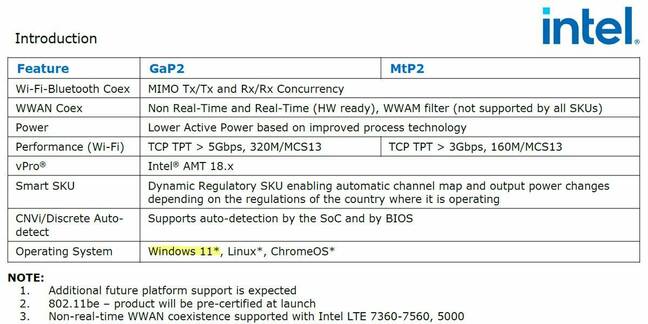Intel seems to think Wi-Fi 7 is too cool for old-school Windows 10
What do you mean, you 'haven't updated yet'?
A leaked Intel document seems to suggest that Intel will only support Windows 11 and later on its next-gen Wi-Fi chipset.
Twenty-eight years ago today, Microsoft released Windows 95. Its influence was lasting. A full 20 years later, Windows 10 bore that version number, skipping version 9 completely, allegedly because even in the 21st century there was still software that checked for a version number beginning with 9.
Yes, Windows 10 is already eight years old, and it's starting to show distinct signs of age. Earlier this year, the news emerged that 22H2 would be its last release, and its official end of life date is October 14, 2025.

Screenshot of leaked Intel document detailing supported platforms for its next-gen Wi-Fi chipset.
That's well into the expected time frame for Wi-Fi 7, or more formally, IEEE 802.11be, which should start shipping next year. If an internal Intel document leaked on Twitter X is any indication, Intel only plans to support this on Windows 11, ChromeOS, and Linux in general.
We've asked Intel for comment, and will update if we hear back.
- Microsoft teases Python scripting in Excel
- Microsoft wants Activision so badly, it's handing streaming rights over to ... Ubisoft?
- Need a decent dining spot in Ottawa? Microsoft suggested a food bank
- PowerShell? More like PowerHell: Microsoft won't fix flaws in package gallery ripe for supply chain attacks
This is not good news if you're hanging on to Windows 10. For instance, if your hardware doesn't have TPM2 chips, as most of The Reg FOSS Desk's PCs do not. As we have covered before, there are workarounds to both enable more customization of Windows 11, as well as to coax it on to non-compliant hardware.
The truly determined may be able to hang on rather longer thanks to LTSC versions. Just last month, Redmond made the 2021 LTSC version of Windows 10 IoT edition available through volume licensing. This the "Long Term Servicing Channel," which replaces the older "Long Term Servicing Branch" – in other words, an edition that will get security updates for five years, and won't receive feature updates. That's a good thing in an OS that is expected to be embedded in digital signs and so on and which ideally won't require direct manual maintenance.
This is based on the 21H2 release of Windows 10, which should get five years of updates, meaning until 2026. This, of course, was cut down from the 10 that it originally promised. Even so, even in hardware-hacking circles, quite a few people in the DIY PC brigade see the LTSC version, with its long support lifetime and promise of no disruptive updates, as a desirable thing, and there is much discussion about how to obtain it if you're not a big enterprise buyer. ®
 Biting the hand that feeds IT
Biting the hand that feeds IT